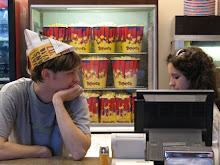 The company Neo Art & Logic will employ some pretty cool technology to create special effects for the sequels "Pulse Afterlife" and "Pulse Invasion," which are shooting back-to-back at Mansfield Studios through Oct. 26.
The company Neo Art & Logic will employ some pretty cool technology to create special effects for the sequels "Pulse Afterlife" and "Pulse Invasion," which are shooting back-to-back at Mansfield Studios through Oct. 26."Pulse" is an apocalyptic thriller about college students who tap into a world of deadly ghosts through wireless frequencies.
I visited with producer Michael Leahy yesterday. The production has a B unit called a plate crew. The three- to five-person team is collecting background images by digitally photographing rundown buildings in Shreveport, Texas and elsewhere. Apparently, the images are high-resolution, 360-degree photographs of buildings and places that will be digitally enhanced and inserted behind the actors, who are doing most of their work in front of a greenscreen.
I was a bit curious as to how the effects team will build their backgrounds from photographs, so I probed. (I've watched all the blockbuster DVD extras, but I have never really understood how moviemakers convincingly blend greenscreen and background footage.)
What's a plate?
"The plate goes down first, and the food goes on top," Leahy said. "All the stuff you shoot on the greenscreen is the foreground. The plate is the background."
I can follow a food analogy. I then asked him to explain how they take these 360-images, which are still essentially flat, and make them look like backgrounds with convincing depth.
I watched how "The Guardian" created its effects in the wave tank in south Shreveport, but the "Pulse" process appeared much smaller and more photographic (and less cinematic) based.
Leahy further explained, "We have a special rig on our still camera that allows us to shoot 360. We shoot the whole surroundings, and we'll go up and down. We actually are shooting in the Z axis as we shoot stills." I missed that in grad school, I thought to myself. Too much Hitchcock, not enough Bruckheimer. "This being a ghost story, it's not a kinetic movie. It allows you to not worry about a lot of that movement in the background plates. It's very creepy, slow way of shooting that caters to the story."
What this basically means is that the "Pulse" effects team does not have to build its backgrounds totally from scratch. The "Pulse" effects team can repaint the dilapidated or eerie structures found in the real world to create the right atmosphere for an apocalyptic horror flick. And it doesn't look flat. How cool is that? (How dumb am I?)
Neo Art & Logic's special effects have a different aesthetic than most you see in major Hollywood movies. You can see a really cool clip reel of theirs by clicking here.
Lastly, I asked Leahy why they brought their technology all the way from Los Angeles to employ it in Shreveport. Apparently, it's very low-tech high-tech, and cost effective. "Right now you can comp out of a Mac Pro computer. The technology we are bringing is just software. It can be just computers and a still camera, so the technology is here."
Anybody want to make my sequel to "Blade Runner?" I got software.
Neo Art & Logic, which is partnering with Weinstein Co./Dimension Films, will be in Shreveport for a while. After the "Pulse" projects, they're shooting two sequels to "Feast," which will use different effects technology to create its monster/living military weapon. Production begins Oct. 29 and will wrap before Christmas. Click here to read more.










No comments:
Post a Comment